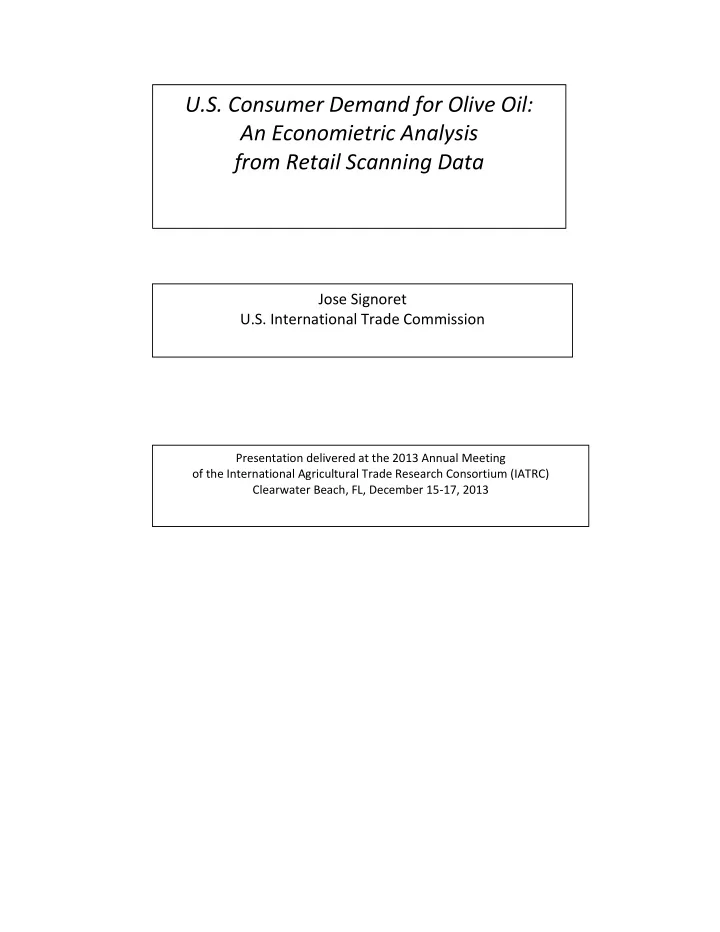

U.S. Consumer Demand for Olive Oil: An Economietric Analysis from Retail Scanning Data Jose Signoret U.S. International Trade Commission Presentation delivered at the 2013 Annual Meeting of the International Agricultural Trade Research Consortium (IATRC) Clearwater Beach, FL, December 15-17, 2013
U.S. Consumer Demand for Olive Oil José E. Signoret U.S. International Trade Commission IATRC Annual Meeting 2013 The views in this presentation are strictly those of the authors and do not represent the opinions of the U.S. International Trade Commission or any of its individual Commissioners.
USITC olive oil study • Requested by the Ways and Means Committee • Demand analysis was conducted as part of chapter 4, “The U.S. Market for Olive Oil” • Provides a quantitative assessment of the role of imports, grading, prices on olive oil consumption 2
Overview • Global production is concentrated in the Mediterranean region (97%) • “New World” producers include the U.S., Australia, Argentina, and Chile • The U.S. produces mostly high-quality extra virgin • Unit costs are relatively high because of lack of scale • Consumption in the U.S. has been increasing rapidly, but from a small base in per capita terms • Many consumers seem unfamiliar with the product and unable to distinguish quality differences 3
Data • Scanning data contain sales information for olive oil at the UPC level • Over 2,000 UPCs are observed in the data – Many correspond to different presentations of the same product – Lot of product differentiation among flavored oils • Sales and prices collected from retail outlets (supermarket, super centers, drug stores, convenience stores) in over 50 regional markets • Reported at a weekly frequency (156 weeks) 4
Aggregations • Aggregate UPCs based on brand, oil grade, and oil source – Abstract from size and container. Harmonize product prices to dollars per liter – STAR Extra Virgin and STAR Extra Virgin California are two product choices • Panels are formed according to the nine Census divisions (Pacific, Mountain, New England, etc.) • For the demand estimation five product groups (segments) are defined 5
Product groups 1. BRA_EV_F : Branded extra virgin foreign 2. UNB_EV_F : Unbranded extra virgin foreign 3. BRA_EV_D : Branded extra virgin domestic 4. ____FL__ : Flavored olive oils 5. ____OT_F : Other olive oils (virgin, refined) • Other groupings are possible • Domestic oil is mostly EV • Estimates for flavored oils are not robust 6
Demand system w t ln( m / P ) ln p idt i id id i dt dt ij jdt idt j for i = 1,…, J • Expenditure shares of product group i in division d at time t are regressed on: – Price indices for each product group – Total expenditure on olive oil – Product-division trends – Product-division fixed effects • Prices are treated as predetermined • Estimated as AIDS and LA-AIDS by SUR 7
Estimated parameters AIDS LA-AIDS i = 1 i = 2 i = 3 i = 4 i = 1 i = 2 i = 3 i = 4 -0.340 -0.337 i 1 (0.121) (0.114) i 2 0.109 -0.220 0.105 -0.213 (0.038) (0.028) (0.032) (0.027) i 3 0.005 -0.006 0.000 0.004 -0.005 0.000 (0.007) (0.004) (0.001) (0.005) (0.004) (0.001) i 4 -0.014 0.007 -0.001 0.017 -0.015 0.009 -0.001 0.018 (0.012) (0.006) (0.000) (0.010) (0.012) (0.007) (0.000) (0.010) 0.013 -0.025 -0.004 -0.008 0.013 -0.025 -0.004 -0.008 i (0.029) (0.016) (0.001) (0.002) (0.030) (0.016) (0.001) (0.002) Own price elast. -1.778 -2.103 -0.992 0.380 -1.778 -2.106 -0.993 0.377 (0.281) (0.148) (0.095) (0.776) (0.281) (0.147) (0.095) (0.773) • Parameter estimates and derived elasticities are robust to the choice of model 8
Estimated price elasticities p1 p2 p3 p4 q1: BRA_EV_F -1.792 *** 0.235 *** 0.009 0.528 *** (0.274) (0.065) (0.011) (0.199) q2: UNB_EV_F 0.619 *** -2.058 *** -0.025 0.598 *** (0.180) (0.187) (0.023) (0.107) q3: BRA_EV_D 0.495 -0.350 -1.002 *** 0.226 (0.427) (0.377) (0.098) (0.199 ) q4: ____OT_F 0.656 ** 0.289 *** 0.003 -2.008 *** (0.279) (0.071) (0.007) (0.217) Note: Elasticities are conditional on total expenditures in non-flavored olive oil. Elasticities evaluated at mean values. Robust standard errors with clustering in parenthesis. • Own price elasticities are negative and highly significant. Substantial sensitivity to price. Significantly less sensitivity to price for the domestic variety. 9
Substitutability • Cross-price elasticities shows significant substitutability among all imported olive oils • Larger substitutability to lower grade than to an unbranded EV – Perceived quality from product branding may be more important than grade • Demand for domestic variety does not show significant substitutability – Other attributes may be important – Domestic oil appears to be a niche product 10
Thank you! jose.signoret@usitc.gov 11
Recommend
More recommend